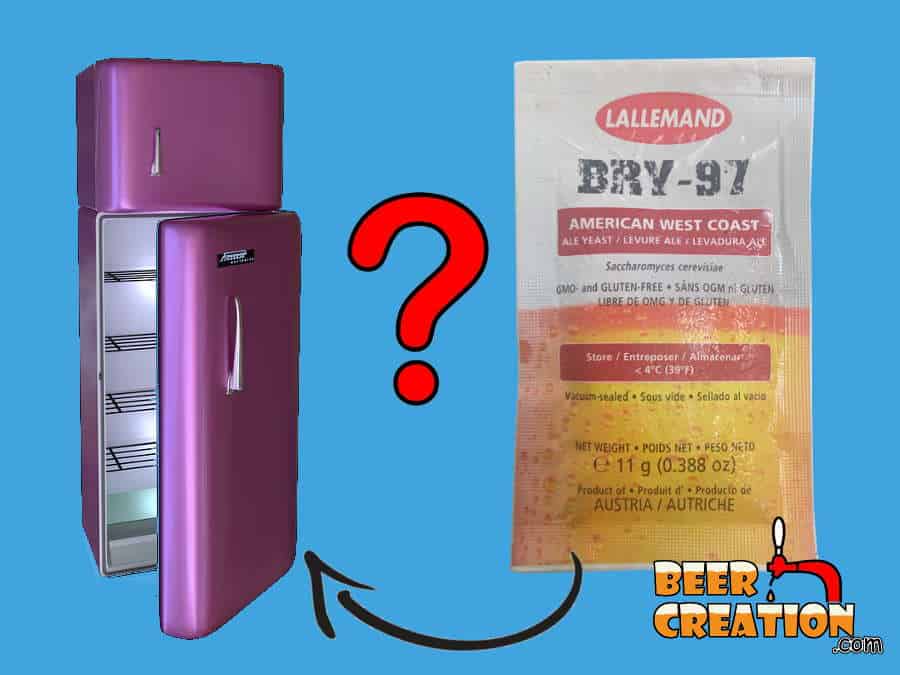As with many new brewers, I had never thought about yeast before I started making beer nor did I really know how to store it. Now, looking back to the run-up to my first brew day I relive my ignorance of proper yeast storage with horror; if only I’d known the answer to this question back then.
So, should beer yeast, whether liquid or dry, be stored in a refrigerator or not? Yeast’s life span can be prolonged from a few weeks to several months by storing it at low temperatures. This is particularly true for liquid yeast packets (6 months) which have a significantly shorter shelf-life than dry yeast (18 months). But, in many cases, dry yeast doesn’t require cold storage.
Although as a general rule you should probably refrigerate your brewer’s yeast, it’s not as simple as that. In this article I go into a lot more detail about storing yeast in different circumstances, so please read on for more information.
Firstly, let’s talk about what yeast is and the different forms of it which you will come across in your career as a brewer, then I will go into more detail about its proper storage.
Type | Unrefrigerated | Refrigerated | Frozen | Opened |
Dry | 12 months | 18 months | 2 years+ | 4-6 months |
Liquid | 2-3 weeks* | 6 months | N/A | 1-4 weeks |
Harvested | 2-6 weeks ** | 5-6 months | N/A | N/A |
* yeast cells will become less and less viable over time and a starter is really needed. **stored as yeast slurry.
What is beer yeast exactly?

I think that it’s important to remember that yeast is a single-celled living organism of the fungus family and so it reacts to the cold as many other similar creatures do.
So, it’s very much about prolonging the life expectancy of these cells as the more viable yeast particles you have in your beer the better your fermentation will turn out.
Another very important thing to remember about yeast is that each variety or strain of the species has its own tolerance to hot and cold temperatures, so as a brewer you really need to understand this better for more efficient results.
Types of brewing yeast
As I’ve already mentioned, yeast comes in many varieties which can help produce a very different beer than the next type of yeast. In addition to this, commercially bought yeast is available in two main formats, liquid yeast or dry yeast. Each type has its advantages and can be stored differently for optimal results.
Dry yeast
Some purists will tell you not to touch dry beer yeast with a 10-foot barge pole, but this perspective may be slowly changing. Dry yeast is yeast cells that have been dehydrated, freeze-dried, and can be stored more easily for later use.
The advantage it has over its liquid cousin is that there are many more yeast cells per packet, it last longer even at higher temperature storage, it’s cheaper and also you don’t need to worry too much about oxygenating your wort before use.
Liquid yeast
Liquid yeast is very popular because it offers such variety in the strains which are available on the market. Also, it is easier to find the exact or very similar strain of yeast used in your favorite commercial brews.
There is also a thriving seasonality of yeast strains which brings more variety to your home brewery. In addition, some beer varieties such as Hefeweizen or Belgian Trappist Ales are nye on impossible to emulate properly without liquid yeast.
However, liquid yeast is generally more expensive than its dry cousin, its cell count can be drastically reduced by improper storage and when this happens you have to use additional packets or even a yeast starter. Also, if you don’t aerate your wort properly you won’t get the expected yeast growth and your final beer will be negatively affected.
Harvested yeast
This is a process used widely in the commercial brewing community and to some extent in homebrewing circles. The basic principle is to recycle healthy and extremely viable yeast from a newly fermented batch of beer. This is usually done when the beer is racked either into a secondary fermenter or into bottles/ a keg for carbonation. As long as you used extremely clean equipment, harvesting your own yeast from a previous brew is both easy and very cost-effective.
Storing dry yeast
Although refrigerating your dry yeast will extend its shelf life, you don’t need to do this. Due to its preparation, as long as you store the packet in a dry and cool place the yeast will survive happily for around a year. However, as a rule of thumb, you should try and use yeast as soon as possible because every month dry yeast will lose about one or two percent of its viable cells.
Before you use the yeast, you need to rehydrate it in warm (but not hot) water for about 20 minutes. This way you’ll get the best out of the yeast cells which have survived through its storage period.
Storing liquid yeast
Liquid yeast is sold in either small vials or what is known as smack packs. Because the yeast is in a more animated form, liquid yeast needs to be stored in a very different way to dry yeast.
When possible, avoid buying liquid yeast during the warm summer months from anywhere other than a local brew shop. Even then, make sure that the yeast didn’t travel too far to reach the store itself. Heat and light can really kill off a lot of the yeast cells in a liquid packet and you could lose 10-20 times more cells than with dry yeast per month.
You should, therefore, put the liquid yeast in a refrigerator (39°F/4° or below) as soon as you buy it (when you get home of course!) and request that it be cooled for transit when possible. When you come to use it (don’t store it for more than 6 months) make sure that you use a starter to make the most of the yeast cells you have available.
Storing yeast slurry
As with many things in the brewing community, getting a clear definition of what ‘slurry’ means is difficult. For some it’s yeast suspended in liquid, for others it’s the yeast cake at the bottom of your fermenter from which we separate viable yeast from other trub. Whatever you define it as let’s agree that we are discussing the same thing here.
Generally, you want to use a yeast slurry solution as soon as you can, however, commercial brewers can store their concoctions for many weeks or even months and still bring life out of them.
Make sure that you store your slurry in a refrigerator when possible in an airtight container for no more than about 6 months, less may be better. If that’s not possible, then again store it as you would dry yeast in a dark and cool place again in an airtight container. You can feasibly do this for around a month. In both cases, you will have to introduce your harvested yeast into your wort in the form of a starter for the best results.
Can Beer Yeast be frozen?
Like many similar single-celled organisms, freezing yeast doesn’t necessarily kill it. In fact, dry yeast is often freeze-dried in the process of producing it. However, it has to be said that freezing can actually damage the cell internal structure, so perhaps it should be avoided whenever possible.
Freezing will suspend yeast’s animation and this means that it can be stored for a fairly long time in your freezer, perhaps indefinitely. However, you will need to give the yeast cells a helping hand to reanimate them before use and a starter is a great way to do this.
However, it’s not really recommended that you try and freeze a liquid yeast packet or harvested yeast. This is because the yeast in these forms are much more active and could be killed off in greater numbers than their dried counterparts. Although I have heard success stories of people freezing at least liquid yeast packets, it doesn’t really seem necessary to do it and take the risk of producing unviable yeast cells.
Reusing yeast from an open packet
In the rare occurrence when you have only used part of a yeast packet, it’s perfectly OK to then reuse the rest of the yeast on another brew day if you have stored it correctly.
As yeast is very susceptible to heat, light, and moisture, you need to put it into an airtight container and pop it in the refrigerator. This is true for both dry and liquid packets.
For open dry packets, if you keep them open packet in an airtight container you can reuse it within about 4 months of first opening the packet. Alternatively, you can freeze the packet, again protecting it from moisture and still use it up to 6 months after usage.
For liquid yeast, you really should try and reuse the rest of the yeast within a couple of weeks, perhaps a month at most.
Storing wine yeast in the refrigerator for a making beer
If for some reason your recipe calls for you to use wine yeast, perhaps for a nice Belgian style ale, then again its shelf-life depends on if it’s in a dry form or liquid. To my knowledge, wine yeast is most popularly packaged as dried yeast cells, but I am willing to be corrected if I’m wrong.
With this being said, the longest that you can expect to have viable yeast cells when stored in cold temperature is the same as beer yeast, 18 months up to a year. Being a different strain of yeast, wine yeast seems to last a little longer than its zythophile cousin.
Storing a yeast starter: To cool or not to cool?
Just so that we are on the same page, a yeast starter is basically like making a mini-batch of beer, minus the hops (shop for your hops online at homebrewing.org)., and introducing yeast into it. This helps promote yeast growth and it’s like sending trained GIs into battle (fermenting your beer) rather than raw recruits.
So, if for some reason you start your yeast starter only to be unable to make your beer in the next couple of days, don’t panic. You can safely leave your yeast to feed on the nutrients in the starter for several days up to a couple of weeks. Once all the ‘food’ is gone, the yeast will knock off work and basically go to sleep.
If you still haven’t got time to brew your beer, then you can actually place your fermented yeast starter into the fridge for a couple of months and then just wake up the dormant yeast with some fresh yeast nutrients.
However, for the best results, I’d recommend that you always try and use a fresh yeast starter whenever possible. But, just be safe in the knowledge that you don’t always have to throw your starter away if something more important gets in the way of your brew day.
Yeast storage container
If you are looking to store your yeast for later use, I can recommend from the polling I’ve carried out in the brewing community, the following three types of containers.
Mason Jars (link to Amazon) these are great inexpensive containers to store and wash your yeast (slurry) in and they come in a range of sizes to meet all your brewing needs.
Boston round bottles (link to Amazon). It’s best to choose the wide mouth version of these laboratory standard bottles. Also, the tempered glass is ideal for both hot and cold temperatures.
Dram Glass Vials (link to Amazon) are great for freezing yeast, if that’s what you need to do, although you will have to separate your harvested yeast into several different vials. Still, these are a great product if that’s the job you have in mind.
What temperature will kill brewing yeast?
As we have discussed in this article, in most cases you can safely freeze yeast and still expect it to be alive and kicking when you reanimate it later for brewing. However, if you go the other way along the thermometer spectrum, you are likely to strike yeast a blow it won’t recover from.
From the information I’ve been given, anything above about 140°F/60°C is extremely unhealthy for yeast and will result in most cells becoming indefinitely unresponsive. So, make sure that when pitching your yeast you bring it down to the recommended temperature for your recipe and nowhere near this yeast-killing figure.





